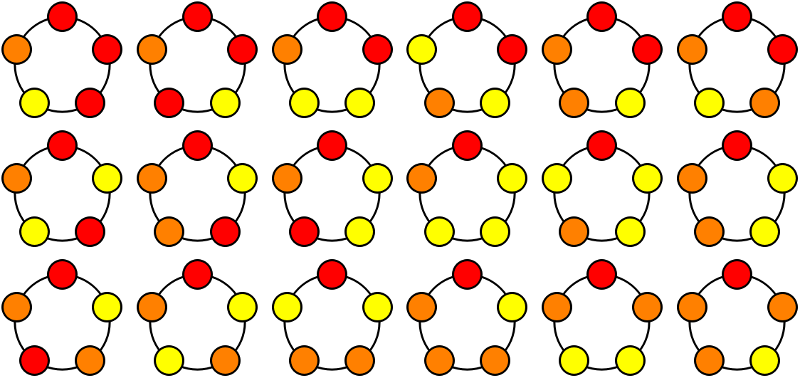• 18 can be written using four 4's:

• There are 18 essentially distinct necklaces that contain 5 beads of 3 colors:

18 has 6 divisors (see below), whose sum is σ = 39. Its totient is φ = 6.
The previous prime is 17. The next prime is 19. The reversal of 18 is 81.
18 is nontrivially palindromic in base 5 and base 8.
18 is an esthetic number in base 16, because in such base its adjacent digits differ by 1.
It is an interprime number because it is at equal distance from previous prime (17) and next prime (19).
It can be written as a sum of positive squares in only one way, i.e., 9 + 9 = 3^2 + 3^2 .
It is a tau number, because it is divible by the number of its divisors (6).
It is an ABA number since it can be written as A⋅BA, here for A=2, B=3.
It is a Harshad number since it is a multiple of its sum of digits (9), and also a Moran number because the ratio is a prime number: 2 = 18 / (1 + 8).
18 is an idoneal number.
It is a Lucas number.
It is an Ulam number.
It is an alternating number because its digits alternate between odd and even.
Its product of digits (8) is a multiple of the sum of its prime factors (8).
It is a Curzon number.
18 is a nontrivial repdigit in base 5 and base 8.
It is a plaindrome in base 5, base 7, base 8, base 10, base 11, base 12, base 13, base 14, base 15 and base 16.
It is a nialpdrome in base 3, base 5, base 6, base 8 and base 9.
It is a zygodrome in base 5 and base 8.
It is a panconsummate number.
It is a pernicious number, because its binary representation contains a prime number (2) of ones.
It is a polite number, since it can be written in 2 ways as a sum of consecutive naturals, for example, 5 + 6 + 7.
18 is the 3-rd heptagonal number.
It is a practical number, because each smaller number is the sum of distinct divisors of 18
18 is a primitive abundant number, since it is smaller than the sum of its proper divisors, none of which is abundant.
It is a pseudoperfect number, because it is the sum of a subset of its proper divisors.
18 is a wasteful number, since it uses less digits than its factorization.
18 is an evil number, because the sum of its binary digits is even.
The sum of its prime factors is 8 (or 5 counting only the distinct ones).
The product of its digits is 8, while the sum is 9.
The square root of 18 is about 4.2426406871. The cubic root of 18 is about 2.6207413942.
Adding to 18 its reverse (81), we get a palindrome (99).
The spelling of 18 in words is "eighteen", and thus it is an aban number, an oban number, and an uban number.
• e-mail: info -at- numbersaplenty.com • Privacy notice • done in 0.069 sec. • engine limits •

